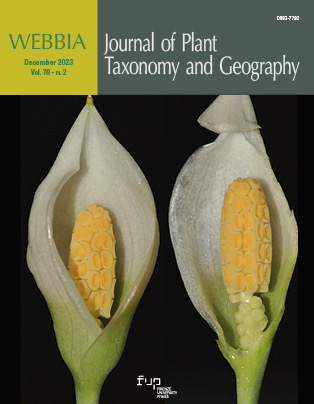Published 2023-10-10
Keywords
- leaf architecture,
- leaf morphology,
- venation patterns,
- Hibiscus rosa-sinensis,
- varieties
How to Cite
Copyright (c) 2023 Clarissa Mae P. Escalona, Inocencio E. Buot

This work is licensed under a Creative Commons Attribution 4.0 International License.
Abstract
Leaf architecture has been successfully used in the taxonomic and systematic studies of many plant families, genera, and species but little employed at the variety level. The present study demonstrated how leaf architecture can be equally important for plant varieties as well. The leaf architecture of four Hibiscus rosa-sinensis L. varieties namely ‘Reddy or Not’, ‘Nay Isa’, ‘Lolay’, and ‘Saskia De Lang’ from the Institute of Plant Breeding was studied. A total of 150 leaf specimens were digitized, examined, measured, and described. The semicraspedodromous pattern of the secondary veins and the angle between the 3° to 1° vein were characters found to have taxonomic significance in describing H. rosa-sinensis species while the angle of the 2° vein was important for delineating H. rosa-sinensis varieties. The resulting dendrogram from the cluster analysis grouped all the H. rosa-sinensis from the outgroup and further created three subclusters that were closely related.
References
- Afable JQ. 2022. UPLB names new Hibiscus variety after Dutch Ambassador Saskia De Lang. Retrieved from https://uplb.edu.ph/all-news/uplb-names-new-hibiscus-variety-after-dutch-ambassador-saskia-de-lang/
- Angiosperm Phylogeny Group. 2003. An update of the Angiosperm Phylogeny Group classification for the orders and families of flowering plants: APG II. Botanical Journal of the Linnean Society. 141: 399-436 doi: 10.1046/j.1095-8339.2003.t01-1-00158.x DOI: https://doi.org/10.1046/j.1095-8339.2003.t01-1-00158.x
- Baltazar AMP, Buot Jr IE. 2019. Short Communication: Leaf architectural analysis of taxonomically confusing coffee species: Coffea liberica and Coffea liberica var. dewevrei. Biodiversitas 20(6): 1560-1567. doi: 10.13057/biodivd200611 DOI: https://doi.org/10.13057/biodiv/d200611
- Barroga JB, Buot Jr IE. 2014. Leaf architecture of ten species of Philippine Terminalia Linn. (Combretaceae). Int Res J Biol Sci. 3(3): 83-88
- Bhat RB. 1995. Taxonomic implications of leaf architecture in the genus Hibiscus. S. Afr. J. Bot. 61(4):209-214 DOI: https://doi.org/10.1016/S0254-6299(15)30516-0
- Buot Jr IE. 2020. Leaf Architecture as promising tool in confirming identity of confusing plant taxa. Journal of Nature Studies. 19(1):134-143
- Cao Y, Yan C, Li J, Zhou H. 2017. Leaf vein extraction and angle measurement using hue information and line detection. 9th International Conference on Intelligent Human-Machine Systems and Cybernetics. 223-225 doi: 10.1109/IHMSC.2-17.58 DOI: https://doi.org/10.1109/IHMSC.2017.58
- Ellis B, Daly DC, Hickey LJ, Johnson KR, Kirk R, Mitchell JD, Wilf P, Wing SL. 2009. Manual of Leaf Architecture. Cornell University Press DOI: https://doi.org/10.1079/9781845935849.0000
- Fuller DQ, Hickey LJ. 2005. Systematics and leaf architecture of the Gunneraceae. The Botanical Review 71(3): 295-353. DOI: https://doi.org/10.1663/0006-8101(2005)071[0295:SALAOT]2.0.CO;2
- Hickey LJ. 1973. Classification of the architecture of dicotyledonous leaves. American Journal of Botany 60:17-33 DOI: https://doi.org/10.1002/j.1537-2197.1973.tb10192.x
- Huiet L, Li FW, Kao TT, Prado J, Smith AR, Schuettpelz E, Pryer KM. 2018. A worldwide phylogeny of Adiantum (Pteridaceae) reveals remarkable convergent evolution in leaf blade architecture. Taxon 67(3): 488-502 doi: 10.12705/673.3 DOI: https://doi.org/10.12705/673.3
- International Hibiscus Society. 2023. Cultivar Search Engine. Retrieved from: https://internationalhibiscussociety.org/
- Laraño AAP, Buot Jr IE. 2010. Leaf Architecture of Selected Species of Malvaceae sensu APG and its Taxonomic Significance. Philippine Journal of Systematic Biology 4: 21-54 DOI: https://doi.org/10.3860/pjsb.v4i0.1563
- LAWG or Leaf Architecture Working Group. 1999. Manual of Leaf Architecture: Morphological description and categorization of dicotyledonous and net-veined monocotyledonous angiosperms. Washington, DC: Smithsonian Institution p. 65
- Loutfy MHA, Karakish EAK, Khalifa SF, Mira ERA. 2005. Numerical taxonomic evaluation of leaf architecture of some species of genus Ficus L. Intl J Agri Biol 7:352-257
- Lu H, Wu J, Ghiassi M, Lee S, Nitin M. 2012. Classification of Cammellia (Theaceae) Species Using Leaf Architecture Variations and Pattern Recognition Techniques. PLoS ONE. 7(1): e29704 doi: 10.1371/journal.pone.0029704 DOI: https://doi.org/10.1371/journal.pone.0029704
- Magdalita PM, Pimental RB. 2013. Development of Hibiscus hybrids ‘Women in Public Service Series II’ and propagation studies on Hibiscus rosa-sinensis ‘Cynthia’. Philippine Science Letters 6(1): 39-56
- Magdalita PM, San Pascual AO. 2021. Hibiscus (Hibiscus rosa-sinensis): Importance and Classification. In: Datta SK, Gupta YC (eds) Floriculture and Ornamental Plants. Handbooks of Crop Diversity: Conservation and Use of Plant Genetic Resources. Springer, Singapore. doi: 10.1007/978-981-15-1554-5_18-1 DOI: https://doi.org/10.1007/978-981-15-1554-5_18-1
- Masungsong LA, Belarmino MM, Buot Jr IE. 2019. Delineation of the selected Cucumis L. species and accessions using leaf architecture characters. Biodiversitas. 20(3): 629-635. DOI: https://doi.org/10.13057/biodiv/d200303
- Medina M, Amoroso V, Kloppenburg RD. 2016. Changes of leaf morphology of Hoya amorosae from varying light exposure: Its implications to species description and taxonomy. Journal of Biodiversity and Environmental Sciences 8(6): 232-237
- Pacheco-Trejo J, Terrazas T, Ochoterena H. 2009. Leaf architecture of the genus Didymaea Hook.f. (Rubiaceae). Plant Sys Evol 281: 137-149. doi: 10.1007/s00606-009-0195-3 DOI: https://doi.org/10.1007/s00606-009-0195-3
- Roth-Nebelsick A, Uhl D, Mosbbrugger V, Kerp H. 2001. Evolution and function of leaf venation Architecture: a review. Ann Bot 87(5): 553-566 doi: 10.1006/anbo.2001.1391 DOI: https://doi.org/10.1006/anbo.2001.1391
- Sharma B, Albert S, Dhaduk H. 2016. Leaf venation studies of 30 varieties of Mangifera indica L. (Anacardiaceae). Webbia: Journal of Plant Taxonomy and Geography 71(2): 253-263 doi: 10.1080/00837792.2016.1175092 DOI: https://doi.org/10.1080/00837792.2016.1175092
- Tan JMP, Buot Jr IE. 2020. Investigating the leaf architecture of Eupolypods I (Polypodiales): implications to taxonomy. Journal on New Biological Reports 9(1): 1-22


